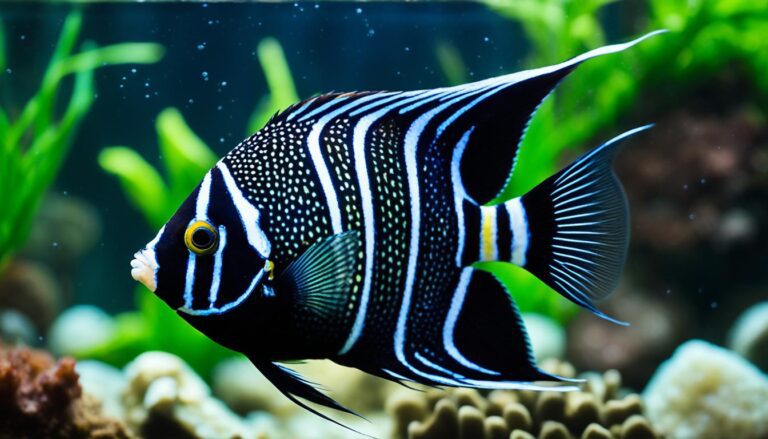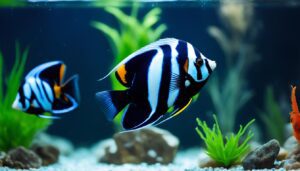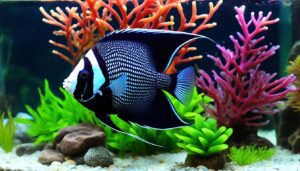Welcome, fellow aquarium fans! If you love the beauty of water life, you’ll enjoy learning about the Black Lace Angelfish. It’s a top pick among freshwater angelfish species. These elegant fish not only make your aquarium look better. They also offer a fun challenge in angelfish breeding for both beginners and experts.
The Black Lace Angelfish has dark, detailed patterns that look like lace. They come from the Pterophyllum genus in South America’s complex river systems. These ornamental fish are loved by many for their lively nature and how easy they are to get. They fit any budget, letting everyone from casual fans to serious collectors add them to their aquariums.
Caring for these special fish is about more than just setting up the right tank. It’s about showing them love too. They need warm water, the right food, and friendly tank mates to be happy. With my tips, you can create a perfect home for your Black Lace Angelfish. Ready to learn more about caring for these fascinating fish? Let’s get started on crafting an amazing aquarium experience together!
Introduction to Black Lace Angelfish: A Majestic Freshwater Species

I’ve always been drawn to the Majestic Black Lace Angelfish’s charm. They come from the Amazon River and add a special touch to tanks. Their dark fins and lace patterns make them stand out as freshwater beauties.
This fish is more than just pretty to look at. It can make any angelfish collection look better with its grace. Learn more about caring for angelfish to keep them looking their best.
To have Black Lace Angelfish in your tank, you need to know a bit about them. They like big tanks with lots of plants and space to swim. Keep the water at 75–82°F and pH between 6.5–7.0 for their happiness.
Black Lace Angelfish prefer peaceful friends in their home. This keeps the tank calm and the fish stress-free. Feed them quality flake food, live, and frozen treats to keep them healthy.
Adding Black Lace Angelfish to your aquarium means creating a peaceful underwater scene. It’s hard work but very fulfilling to see them thrive. They’re not just fish; they’re living art in your home.
Unveiling the Black Lace Angelfish: Origins and Distinctive Features
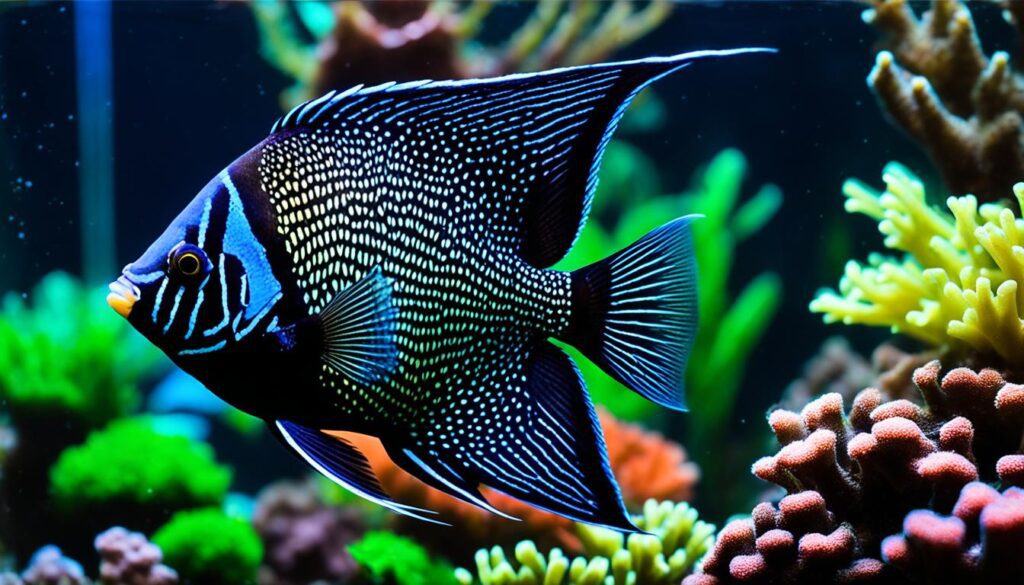
The story of the Black Lace Angelfish is truly captivating. It starts from selective breeding in the mid-20th century. This species is a result of genetic expertise, showcasing beauty and toughness. The history of angelfish breeding is both fascinating and scientific. Enthusiasts and geneticists have worked hard to achieve the beauty we see today.
Looking past their beauty, let’s explore what makes the Black Lace unique.
Historical Breeding and Aesthetic Value
The creation of the Black Lace Angelfish was no quick process. It comes from years of careful breeding. This was done to improve both its health and looks for aquariums. Today, this angelfish is not just a fish; it’s a work of art from the 1950s. Its popularity has grown because of its unique black and silver veils.
Identifying Characteristics: From Fins to Color Patterns
When you look at the Black Lace Angelfish, its beauty stands out. Adults have large, flowing fins and a dark body with silver or gray patterns. These features not only make it a great pet but also a showpiece in aquariums. Their fins and the way they reflect light are why they’re loved by many aquarists.
Knowing about these aspects helps us appreciate the effort in breeding and caring for them. Recognizing their history and special traits enables aquarists to give them the best care, focusing on their well-being and appearance.
Creating the Ideal Habitat: Tank Setup and Requirements for Black Lace Angelfish
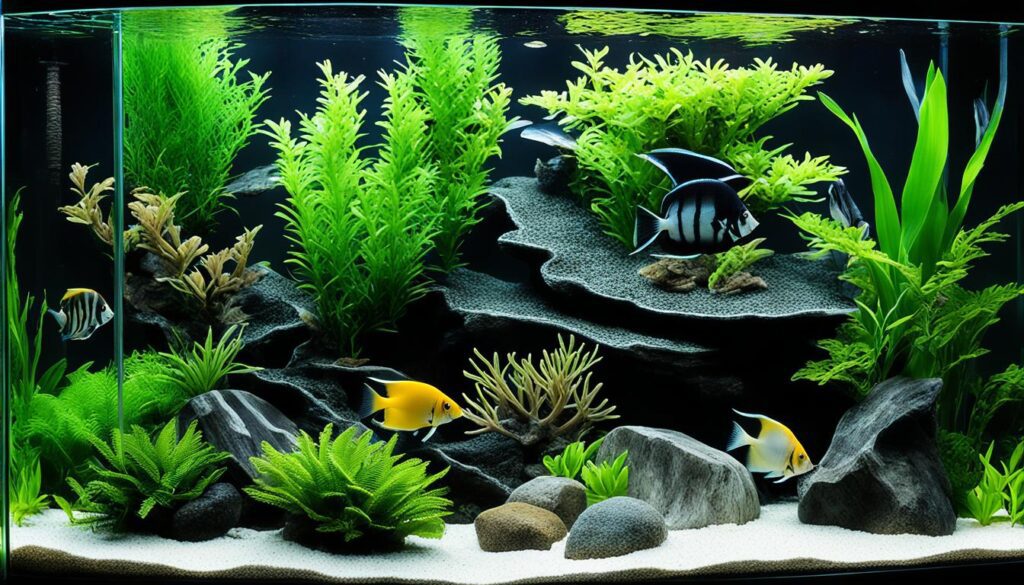
Setting up the perfect home for Black Lace Angelfish is more than just water and fish. It demands insight into tank size, aquascaping, and the best water conditions. We will explore how to make a great environment that feels like their natural home.
Size Matters: The Right Tank Dimensions
Choosing the correct tank size is crucial for Black Lace Angelfish. They need space to grow and move. For one fish, at least 20 gallons is necessary. A community or pair requires 40 to 55 gallons. Large spaces make angelfish less stressed and healthier.
Aquascaping for Angelfish: Plants and Decorations
Good aquascaping is vital for creating a fitting habitat. Add driftwood, smooth rocks, and live plants such as Amazon Sword and Anubias. These elements make the tank look nice, give hiding spots, and lower stress. Ensure decorations are safe and don’t hurt your fish’s fins.
Water Parameters: Temperature, pH, and Hardness
It’s crucial to keep water conditions perfect for Black Lace Angelfish. They like water temperatures from 75°F to 84°F and a pH of 6.5 to 7.5. Change the water 33% to 50% weekly to maintain these conditions and keep your angelfish happy and stress-free.
Tank Requirement |
Parameters |
Notes |
|---|---|---|
Freshwater Angelfish Tank Size |
Minimum 20 gallons for one, 40 for a pair |
Ideal to reduce stress and provide swimming space |
Temperature |
75–84°F |
Optimal for health and breeding conditions |
PH Level |
6.5–7.5 |
Keeps water conditions ideal for angelfish |
Water Changes |
33%-50% weekly |
Necessary to maintain water quality |
Knowing the essentials of angelfish tank setup is key to a thriving tank. From tank size to aquascaping and managing water, each part is important. A well-thought-out aquarium ensures your angelfish are healthy and happy. Always aim for a tank that supports their lifestyle well.
Nutritional Needs: A Comprehensive Feeding Guide for Black Lace Angelfish
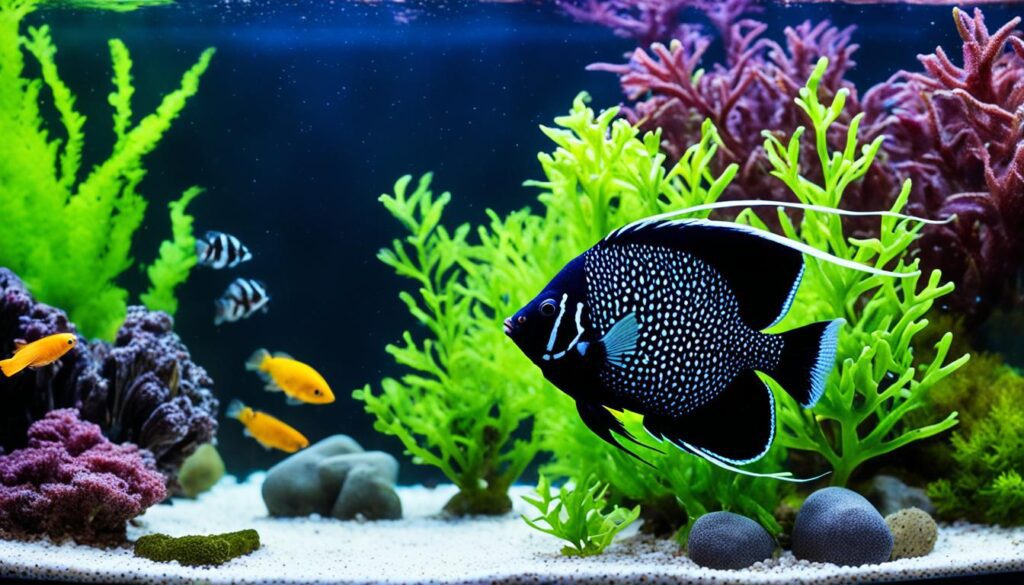
Ensuring your Black Lace Angelfish thrive involves more than just cleaning the tank. They need a diet tailored to their omnivorous nature. A balanced diet keeps these fish healthy and their colors bright. Let’s explore what they should eat to stay healthy and vibrant.
Understanding the Omnivorous Diet
The diet of Black Lace Angelfish includes plant and animal sources. In nature, they eat a variety of foods. A mix of quality flake foods, brine shrimp, and veggies like spinach is essential. Feed them specialized pellets daily, and give treats like frozen or live foods occasionally.
Frequency and Portion Control in Feeding
Feeding angelfish regularly is crucial. Feed young Black Lace Angelfish small amounts three to four times daily. This supports their growth without overwhelming them. Adults need two meals a day, eaten within three minutes each time. Avoid overfeeding to prevent water pollution and health issues.
The goal is to imitate their natural feeding habits with varied foods. This promotes their health and lifespan. Watch how they eat and adjust food amounts as needed. By focusing on their diet, your angelfish will not only live but flourish in your care.
Maintaining Harmony: Compatibility and Social Behavior of Black Lace Angelfish
Creating a healthy tank is all about understanding fish relationships. For Black Lace Angelfish, getting along with tank mates matters as much as the quality of water. It’s important to pair them with friendly species to keep their home peaceful. These fish do best in warm water, between 75°F and 85°F (24°C to 29°C). Make sure this fits the needs of their companions too.
Peaceful Tank Companions: Who Makes the Cut?
Living together in a tank means thinking about how each fish behaves and what it needs. Look for fish that like calm spaces and aren’t aggressive, like black skirt tetras, adult cardinal tetras, and cory catfish. They usually get along with angelfish. But stay away from fin nippers and very small fish; they could become targets. Also, don’t overcrowd the tank to avoid fights over territory and resources.
Understanding Territoriality in Community Tanks
Angelfish can get territorial, especially when it’s breeding season. It’s crucial to give them enough room and places to hide in the tank. A detailed study by Wet Web Media discusses how tank size and conditions affect fish stress and behavior. While a bigger tank can be good, keeping the water conditions stable is key. This keeps aggression low and helps prevent ailments like fin rot, linked to stress. By creating a natural, healthy environment, you ensure your angelfish and their neighbors stay happy and healthy.
